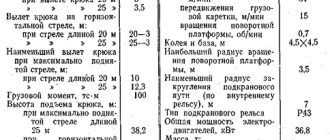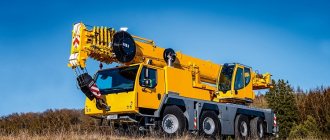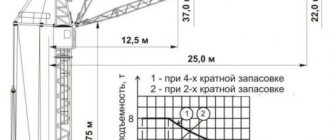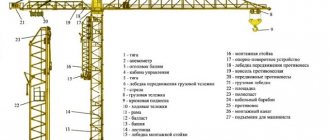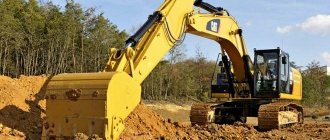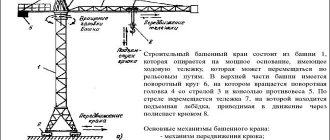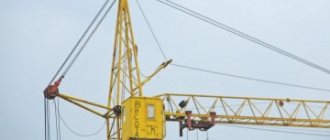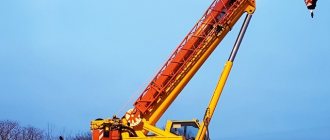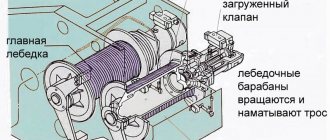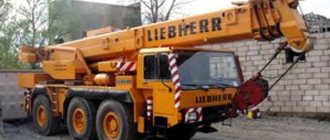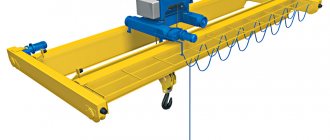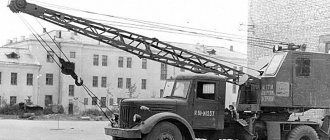The KB-100 tower crane is designed for the construction of high-rise multi-storey buildings for residential, administrative and industrial purposes. The self-propelled tower crane is equipped with a rotating tower structure and an inclined boom.
Special equipment is marketed in two variations: with a tubular and lattice type tower (boom). The load moment of the KB-100 is 100t/m, which allows the installation to be used for moving cargo when performing large-scale and highly loaded work.
instruction manual, technical specifications, price, analogues
| Dimensions | Length - 10900 mm Width - 2500 mm Height - 3640 mm |
| Maximum load moment | 125 TM |
| Maximum reach of boom equipment | 25000 mm |
| Maximum weight of transported cargo | 8000 kg |
| Lifting height | 33,000 mm |
| Load lowering depth | 5,000 mm |
| Crane rail type | P50 |
| Load lifting speed | 20 m/min |
| Platform rotation speed | 70 cm/min |
| Largest outer turning radius | 3500 mm |
| Number of crane rails | 8 |
| Rail radius | 7500 mm |
| Electric motor power | 37kW |
| Ballast weight | 28400 kg |
| Operating temperature | -40°…+40°С |
| Maximum transport speed | 60 km/h |
| Boom equipment | Folding type |
| Chassis model | Ural-4320 |
| Number of sections | 3 |
| Controls | Levers |
| Front drive axle load | 149200 kg |
| Load on the rear bogie | 8,900 kg |
| Type of fuel used | Diesel |
| Power unit model | YaMZ-53622-10 |
| International environmental standard | Euro 2 |
| Equipment power | 240 horsepower |
| Center locking mechanism | Eat |
| Centralized tire inflation system | Eat |
| Interwheel blocker | No |
| Allowable approach angle | 35° |
| Allowable departure angle | 27° |
| Number of hydraulic cylinders in the boom | 1 |
| Wheel formula | 6*6 |
specmahina.ru
Tower crane KB-301 (KB-100.2)
The KB-100.2 crane (Fig. 4) is a modification of the KB-100.1 crane, intended for the construction of buildings up to 9 floors. A distinctive feature of the crane is its telescopic tower. The inner part of the tower is pulled out when the boom is lowered by a cargo winch using a special rod and a four-fold pulley. In the extended position, the inner part rests on the side stops of the outer column and is centered in it by two rows of fingers. An additional ballast weighing 5 tons is placed on the running frame.
Rice. 4. Tower crane KB-301 (KB-100.2) (a) and load characteristics of the crane KB-100.3 (b): 1, 2 - respectively two - and - fourfold reeving of the cargo pulley
Technical characteristics of the crane KB-301(KB-100.2)
| Load capacity, t | 5 |
| Reach, m | 10-20 |
| Lifting height, m | 31-33 |
| Speed, 10-2 m/s: | |
| rise | 43; 21 |
| landings | 8; 4 |
| crane movement | 48 |
| Rotation speed, min-1 | 0,7 |
| Time of full departure change, s | 42 |
| Installed power of electric motors, kW | 34 |
| Crane weight, t: | |
| general | 51,2 |
| constructive | 26,8 |
| Notes: 1. The minimum radius of curvature of the track is 7 m, the track and base are 4.5 m. 2. The lower limit of the load capacity and lifting height corresponds to the largest reach, the upper limit to the smallest. |
hydrotechnics.ru
Modifications of special equipment
A tower crane of this model has been produced on the Russian special equipment market since 1964. Over the period of its existence, the KB-100 was repeatedly modified: the designers made changes to the design of the main components of the equipment, thereby adapting it to the possibility of use in various climatic and operating conditions. The most popular crane installations in modern construction are the following models:
Tower crane KB-100. OAS-1 - design
- 100.0 – equipped with a multi-motor drive with standardized mechanisms;
- 100.1 – equipped with a beam boom with a load trolley, special equipment is applicable in areas of high windiness, as well as in the construction of bridges;
- 100.2 – differs in the design features of the tower, which is made of two sectional pipes;
- 100.3 – a distinctive characteristic is the ability to lift a load weighing 8 tons; the special equipment is also equipped with a lattice-type inclined boom;
- 100. OA – the installation is equipped with semi-automatic rail grips, the operator’s cabin is characterized by a high level of ergonomics;
- 100.0AC – special equipment is equipped with everything necessary for operation in harsh climatic conditions (air temperatures down to -60o C, strong gusts of wind);
- 100.0AC-1 - the model is equipped with additional boom sections, which increases the size of its reach by 25 meters.
Tower cranes of the 3rd size group
General information
Tower cranes of the 3rd size group with a load moment of 100 t m (for the basic version) are intended for mass multi-storey residential and civil construction of buildings up to 12 floors high, as well as for mechanization of work in warehouses and landfills and work on the zero cycle of buildings.
All cranes are designed to operate in temperate climate areas with ambient temperatures of -40... +40 °C, and only KB-309HL type cranes are designed to operate in cold climates with temperatures up to -60 °C.
The cranes can operate in areas with a seismicity level of up to 6 points inclusive according to SNiP II-7-81*. When working in areas with seismicity of 7-9 points, cranes must be additionally designed for the corresponding seismic loads.
Cranes can be operated in those windy areas in accordance with GOST 1451-77, which are written in their passports.
The fundamental design of tower cranes of the 3rd size group of the KB series is the same. All cranes are made with a rotating tower and a lower counterweight, which ensures their mobility during transportation. When transporting from site to site, cranes are transported in the most enlarged form as part of a crane-tractor road train. The crane 2 itself is transported on a four-wheeled dolly 3 connected to the tractor 1 (Fig. 1).
Fig.1. Transportation of a tower crane by road:
1 - tractor; 2 - tap; 3 - dolly carts
According to the design of the booms, the cranes are produced with lifting (cranes of types KB-100, -309ХЛ, SK-3861) and with beam booms (KB-308, -309-04АХЛ, -372). Each of these types of arrows has its own advantages. Cranes with luffing booms have less weight, are easier to install and transport, and allow for greater lifting heights with the same tower height. Cranes with a beam boom provide better installation properties due to the use of less drive power for the mechanism for changing the reach, strictly horizontal movement of the load and its smoother movement when changing the reach. The parameters of taps of the 3rd size group are given in tables 1 and 2.
Table 1
Technical characteristics of tower cranes of the 3rd size group
| Index | KB-100.1 | KB-100.1A (KB-302A) | KB-100.3 | KB-100.3A.1 | KB-100.3A.2 | KB-100.3B | SK-3861 version 1/version 2 | KB-308 | KB-308A | KB-308A.1 | KB-308A.2 |
| Maximum load moment, t m | 100 | 125 | 137 | 100 | 125 | ||||||
| Net load capacity, t: | |||||||||||
| at maximum reach | 5 | 4 | 5 | 4 | 3,2 | 4 | 5 | ||||
| maximum | 5 | 8 | 11 | 8 | |||||||
| Reach, m: | |||||||||||
| greatest | 20 | 25 | 30 | ||||||||
| at maximum load capacity | 20 | 12,5 | 15,6 | 12,5 | 15,6 | ||||||
| least | 10 | 12,5 | 4,8 | ||||||||
| Lifting height, m: | |||||||||||
| at maximum reach | 21 | 33 | 24 | 33 | 11/7 | 32 | 26,4 | 20,8 | |||
| with an inclined boom | — | 42 | 36,4 | 30,8 | |||||||
| at minimum offset | 33 | 48 | 39 | 48 | 26/22,5 | — | |||||
| Lowering depth, m | 3 | 5 | 15 | 5 | |||||||
| Speed, m/min: | |||||||||||
| lifting a load of maximum weight | 20 | 26 | 14 | 16 | 18 | 11,25 | 18 | 16 | |||
| lifting maximum | 20 | 26 | 28 | 48 | 70 | 11,25 | 60 | 48 | |||
| smooth cargo landing | 5 | 5/2,5 | 4 | 2,5 | 5/2,5 | ||||||
| crane movement | 30 | 28 | 40 | 18,5 | |||||||
| movement of the cargo trolley | — | 27,2 | |||||||||
| Reach change time, m/min | 0,5 | 0,7 | 0,8 | — | |||||||
| Crane rotation speed, min | 0,7 | 0,77 | 0,7 | 0,77 | |||||||
| Rear clearance, m | 3,5 | 3,6 | 3,5 | 3,6 | |||||||
| Path curvature radius, m | 7 | 8 | |||||||||
| Installed power, kW | 34 | 40 | 41,5 | 74,9 | 45,6 | 83 | 86,6 | ||||
| Weight, t: | |||||||||||
| constructive | 27,0 | 32 | 34 | 30,6 | 37 | 24/21 | 38 | 39 | 37,8 | 36,6 | |
| counterweight | 27,2 | 40,3 | 35,6 | 39 | 43,3 | 35,2 | |||||
| ballast | — | 25,4 | — | 18 | 9,1 | ||||||
| general | 54,2 | 72,3 | 95 | 91,6 | 76 | 64,3/67,3 | 88,3 | 92,2 | 82,1 | 80,9 | |
| Wheel load on rail, kN | 200 | 240 | 200 | 210 | |||||||
Note. For all crane models, the track base is 4.5x4.5 m.
table 2
studfiles.net
The KB-100 tower crane has a well-thought-out design
The KB-100 self-propelled tower crane is used in the construction of residential and commercial buildings up to 9 floors high. It has a reinforced design and operates in a wide temperature range. It is used on almost any site and can be additionally equipped with platforms to increase stability and operational safety.
Characteristics of the KB-100 tower crane
The maximum lifting capacity of the equipment is 5 tons. The minimum boom radius is 10 m, the maximum is 20 m. It has a tower crane with 100 tons per meter of cargo lifting, which determines the features of its operation. The model can be equipped with two types of winches and specialized electrical equipment.
The arrow consists of 4 parts: root, head and 2 intermediate ones.
It is characterized by ease of boom rotation due to modern control mechanisms. The KB-405 model is very often used on construction sites.
Loading capacity of special equipment
Modifications of the model can lift loads weighing up to 10 tons. The lifting height directly depends on the boom reach. The maximum lift of materials KB-100 is 33 m with the boom folded. With a maximum reach of 20 m, the maximum height is 21 m. The load at any position of the boom can be 5 tons. The KB-100 tower crane has technical characteristics that allow the construction of buildings to be carried out profitably and quickly.
Commissioning of equipment
The crane is moved using trolleys, two of which are leading. The 4.5 x 4.5 m square undercarriage provides increased stability. The rail track allows you to install equipment at the most convenient distance from construction materials and the building being constructed. The operator's cabin is well protected and firmly secured. Includes underfloor heating and a special duct system that guarantees heating and defrost glass for full visibility. Changing the position of the boom and moving loads is carried out using a universal system of levers and buttons. The control panel has a boom angle indicator and alarm indicators.
Cost of tower crane services
The possibility of use for long-term or short-term construction allows small companies to order the services of the KB-100 crane. The high productivity provided by the rotating boom affects the cost of the equipment. The price for a tower crane 100 differs by year of manufacture. Models from the 90s can be purchased for 6-10 thousand dollars. Modern modifications with improved mechanisms are sold at prices ranging from 20 thousand dollars and above. The cost of rent is determined according to its type: with the operator of the rental company or with a private contractor.
The high quality and reliability of the KB-100 tower crane is determined by carefully designed design elements. The KB-473 tower crane also has excellent characteristics. Before operation, it is mandatory to study the condition of the equipment and its maintenance. All work on managing and moving cargo must be carried out in accordance with the instructions, taking into account the instructions and requirements of the manufacturer. It is unacceptable to overload the boom or use it in areas where the equipment does not have sufficient stability.
kowsh.ru
Crane repair procedure
The operation of a crane is rarely complete without repair work, which begins with the preparation of the workshop area: the removal of all unnecessary parts and things that impede the process of restoring the crane. During repairs, the unit must be disconnected from the network. The shop log records the date of repair and the person responsible for carrying it out. Workers are provided with a work permit for repairs, and special technical documentation is drawn up.
Overhead crane repairFirst you need to disconnect or isolate the trolley section by placing a sign: “Caution, live”
It is important to carefully inspect the crane gearboxes and clean the inspection hatch from dirt if it has clogged the cavity of the gearbox. After cleaning the cavity, it is filled with lubricant.
During maintenance of overhead cranes, the safety system is checked, and if there are deviations, worn friction linings and hinges for the brake lever system are replaced.
In general, repairs include the following stages:
- thermal;
- metalwork;
- turning;
- surfacing;
- milling;
- gear cutting;
- grinding.
Overhead crane trolley diagram
Review of tower crane KB 100
The KB 100 tower crane comes in two types. The first manufacturing option for this faucet is lattice, the second is tubular. Based on the unified components, a large group of cranes was designed: KB-100.0M and KB-100.2, suitable for building houses with up to nine floors. KS-100 is used for zero cycle work, KP-100 is most often used for loading work in warehouses. Cranes of the KB-100.1S series are used for work in the Far North.
The KB-100 tower crane is similar in structure to the KB-60. The running frame has a square box section. A welded ring assembled from segments is located at the top, with the help of which the frame is connected to the rotating support ball circle.
The weather vanes are hingedly attached to the running frame at the corners. The weather vanes themselves rest on running two-wheeled balancing trolleys, each of which has a lifting capacity of 40 t. The weather vanes are fixed in the working position by inserting fingers into the holes of the lugs of the running frame and the weather vane. To carry out transportation, as well as to reduce transport dimensions, the fingers fixing the weather vane are removed, thereby allowing them to be reduced to the longitudinal axis of the frame.
The platform on which the crane is rotated is made in the form of a welded structure, rectangular in appearance, with ring segments for attaching a ball circle, which in turn are welded to the bottom of the platform. The circle has external gearing. By the way, in the first models of cranes, Novikov gearing was used, but now cranes are produced using involute gearing technology.
The following mechanisms are also located on the platform: lifting winch L-500, electrical equipment cabinet, boom winch L-450, turning mechanism and counterweight plates.
The boom and tower are made of lattice from corners, with a cross section of the tower of 1.4 by 1.4 meters. The ladder, designed to lift the crane operator into the cabin, is located directly inside the tower. Being in a vertical position, the tower is strengthened with the help of struts. The use of fixation using struts is relevant at a height of 3.4 m. There is a hinge on the head of the tower, relative to which the head rotates sideways. This was done to reduce the transport length of the entire crane during transportation. The valve arrow consists of a base, two intermediate ones and a head.
osnpred.ru
with a fixed tower and a rotating platform, attached, stationary, self-elevating, mobile
Types of tower cranes by platform type
Depending on whether the platform of the tower crane rotates, the devices are:
- With a rotating platform. It consists of an all-welded frame and three beams. Trusses are attached to two beams. It is these elements that bear the load during crane operation. The platform has brackets that serve to fix the cargo and boom winches. Electrical appliances are also located here. The base for the tower is the lower counterweight.
Such cranes are used in the construction of low buildings when the work is short in time. This is because slewing platform cranes can be quickly transported and assembled.
With a fixed tower. Despite the fact that the crane platform itself does not rotate, there is a rotating element. This is the head, which is located at the top of the tower. On one side, a counterweight is attached to the head, and on the other, an arrow. These elements balance each other. Cranes with a fixed platform are used in the construction of high-rise buildings and structures.
Scheme of tower cranes with a rotating platform and a non-rotating towerTechnical characteristics
| Options | Slewing Cranes | Fixed tower cranes |
| Load capacity | up to 25 | up to 75 |
| Load lifting height, m | up to 90 | up to 220 |
| Boom radius, m | up to 40 | up to 80 |
Types of arrows
Tower crane booms can be classified according to the method of departure:
- Lifting. They are used to lift a load, but cannot move it horizontally. The operation of such an arrow is based on a mechanism that changes the angle of lift.
- Beam. This boom is installed statically in a horizontal position. It is not capable of changing the lifting height of the load. The boom has a movable mechanism that grips and moves the load along the skids.
The following classification of arrows is based on a design feature:
- hanging;
- suspended with balancer;
- hanging with a jib;
- hanging with stands;
- hammer-shaped
According to the type of arrow section there are:
- square;
- rectangular;
- triangular.
Tower crane booms can be installed in several ways.
The most cost-effective and fastest assembly method is to attach the boom and winch to the tower in a lying position on the ground.
The structure is lifted using its own winches. The second way is to build a constructor. That is, the crane elements are assembled one at a time in a vertical position at once, and the boom is raised last before connecting the electric current.
Types of cranes by tower type
Based on the design features of the towers, cranes are:
- Lattice. The tower is a structure that is assembled from corners and narrow tubes. The main elements of a lattice tower are the sides with upper and lower ribs, perpendicular and inclined rods. The lattice structure is both strong and lightweight. It reliably resists gusty winds.
- Solid-walled. Such towers have a very simple design, but are heavy. The towers are capable of lifting heavy loads. They are indispensable when working in low temperature conditions.
Classification of cranes depending on the support
Quite often, when distinguishing different types of tower cranes, a feature such as a support is used:
- Mobile. This type of tower cranes is characterized by the possibility of installing a mobile axle with wheels or a rail running under the frame. The crane is not disassembled during transportation; it is enough to remove the counterweights.
- Attached. The running gear of such tower cranes is completely absent. They are mounted on the foundation of the building being constructed, and the tower is fixed vertically to the supporting structures of the building.
- Self-elevating. Such cranes are installed in the middle of the building. They have a lifting ring that rests on the structure's floors. The winch helps move the tower up.
- Stationary. The cranes are attached to the foundation, but the tower is not fixed vertically.
Mobile, stationary, attached and self-climbing tower cranes
Tower crane KB-100.1. Electrical circuit diagram
Details Parent category: Crane diagrams Category: Electric crane diagrams (free) Published: March 24, 2011
Tower crane KB-100.1. Electrical circuit diagram.
List of electrical equipment for crane KB-100.1.
G1-vortex brake generator TM-4;M1-M5-electric motors MTV-411-8S, 16 kW, MT-111-L6, 3.5 kW, MTV-211-6, 7.5 kW;M6-electric brake motor TKTG , AM, 0.2 kW;QF1-automatic switch A3114/1 for 100 A;S-introductory box YAVZ-22;KM1-KM8-reverse contactors KPD-121A;KM9-KM16-acceleration contactors KPD-121A;KM18-contactor switching off the generator KPD-121A; KM17 linear contactor KPD -121A; KT1-KT5 time relay REV-811, 220V coil; KA5-KA6 intermediate relay EP-41/33B; KA1-KA4 maximum current relay REO-401na 60, 10, 40A;SQ1-SQ11, SQ14-limit switches KU-501, VU-250, KU-504, VK-211, VK-411;SQ12, SQ13-emergency switches VU-222A;SA1-SA4-command controllers KK -8661, KK-8562, KK8461, KK8761;SA5-control circuit switch UP-5312/S86 for 380 V, 20 A;SB8-boom brake control switch VK-411;Q1-Q4, Q6-package switches PV2-10; Q5 - siren switch VK-44 for 500 V; TV - step-down transformer OSO-0.25, 220/12 V; UZ - selenium rectifier VSD-4; R1 - resistor in the excitation winding circuit of the generator CP-200; R2, R3 - Tubular resistors. PE-50 for 600 and 250 Ohms; R4-R8 - ballast resistors NK-1, UK-6, NF-2; SB1-SB10 - control buttons KU-1; R9 - tubular resistor PE-15 for 3500 Ohms; YB1- YB5 - electrohydraulic and electromagnetic brakes TKTG-300, MO-100B; PV - voltmeter E-30, 0-450 V; NA - siren RVP-200 at 220 V; EL1-EL4 - floodlights PZM-45, PZM-35 at 220 B; EL5 - cabin lighting lamp SK-6 for 220 V; EL6-EL9 - staircase lighting lamps in column C-131 for 12 V; EH1 - electric cabin heating device PT-102 for 220 V, 1000 W; HL3 - position warning lamp line contactor for 220 V; FU1-FU8 - fuses PR-2 for 6 A; FU9, FU10 - installation fuses PK-45-2 for 6 A; FU11, FU12 - fuses PR-2 for 10 A; HL1, HL2 - light turn position display TS-2; XS1—XS3 - RPK-6 sockets for 250 V, 6 A; KA - maximum current relay contact; KM19 - load limiter contact OGP-1 type; the rest - contacts
The diagrams presented in this section were scanned from various textbooks, reference books, etc.
Using these diagrams, you can get acquainted with the general principles of the operation of mechanisms, but for work (repair, adjustment...) it is not recommended to use them, since their reliability is not guaranteed.
kran-el.ru
